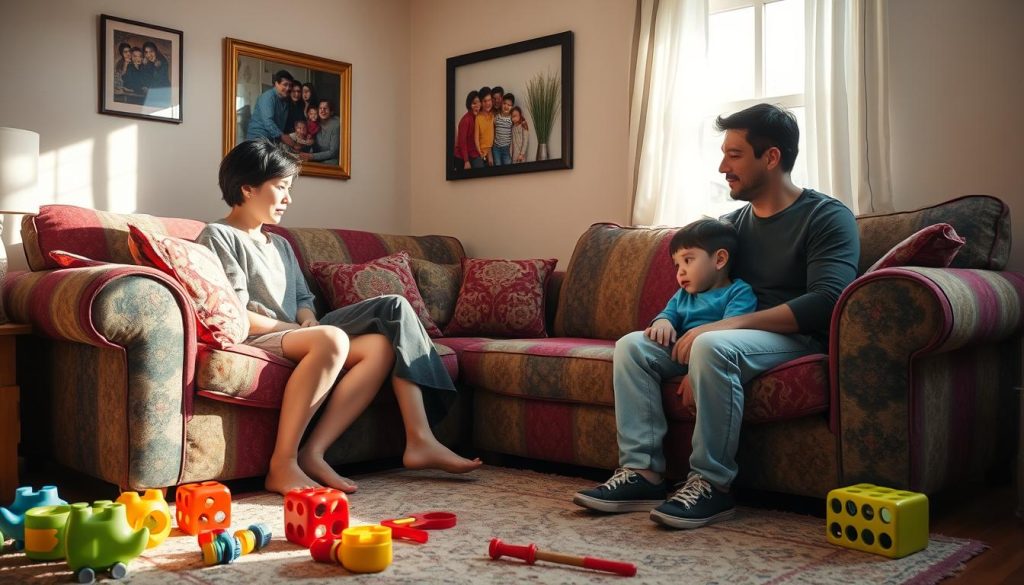Ever wondered why your stepchild might not like you, even when you try your best? Looking into why they act this way can help you understand them better. Often, their behavior is due to deep feelings, not because they dislike you.
Children dealing with their parents’ divorce and a new stepparent face many challenges. They might feel left out, torn between loyalty, or scared. These feelings can make them push away from their stepparent, making parenting tough. Knowing what they feel helps you connect better with them.
Key Takeaways
- Stepchild resistance often stems from complex emotions rather than personal dislike.
- Patience, empathy, and setting clear boundaries are crucial in these situations.
- Family meetings can clarify roles and alleviate fears of replacement or abandonment.
- The stepchild’s dislike usually reflects their reaction to changes in family dynamics, not a personal rejection.
- Understanding the reasons behind a stepchild’s behavior can significantly enhance your approach to building a positive relationship.
Understanding the Reasons Behind the Dislike
When a stepchild shows hostility, it’s key to find out why. This helps create a better family atmosphere. We start by looking at the biological parent’s role, the child’s fear of being replaced, and adjusting to new family life.
Influence of the Biological Parent
The bond between a child and their biological parent is strong. It can make them wary of a stepparent. To ease these worries, reassure them and involve the biological parent in positive ways.
Research shows that primary caregivers greatly influence a child’s behavior and happiness.

Fear of Replacing the Biological Parent
Children often fear their bond with their biological parent will change with a stepparent. This fear can show as resentment or hostility. Keeping communication open and making sure the child feels secure about their bond can help.
Explaining that each parent has a special role can also help. This can reduce the effects of middle child syndrome, which can be worse with new family dynamics.
Adapting to New Family Dynamics
Adjusting to new family setups and rules can be tough, especially for kids who have changed homes a lot. It’s important to remember that enforcing new rules can cause stress and resentment. Children may feel overwhelmed by sudden changes, like tantrums and screaming.
Talking openly about these changes and introducing them slowly can ease the transition.
Understanding the reasons behind a stepchild’s dislike, from the biological parent’s influence to adjusting to new dynamics, is crucial. It helps create a healthier, more supportive family. While parenting tips are helpful, recognizing the challenges of forming new family bonds is also key in dealing with issues like middle child syndrome and childhood eating disorders.
Building Trust with Your Stepchild
Building trust with your stepchild is key to a strong, loving bond. It needs open talks, quality time, and respect for their space. Bonding with a stepchild takes time and effort, showing your dedication.

Open and Honest Communication
Talking openly is vital for trust. Discussing puberty and other sensitive topics makes them feel safe to share. Listening without judging and validating their feelings is crucial. This approach teaches respect and consent, strengthening your bond.
Spending Quality Time Together
Doing things they enjoy shows you care. It could be a hobby or a simple outdoor activity. This quality time strengthens your connection. Remember, younger kids might bond faster, but older ones, especially teens, need more time.
Respecting Their Space and Privacy
Respecting their privacy is also crucial. Most stepchildren want less physical affection and no punishment. Not intruding on their space shows you respect their freedom. This builds trust and makes them feel safe and valued.
Building trust with your stepchild is like cooking a slow-cooked meal. It takes time, patience, and effort. By following these steps, you create a loving, supportive home where they feel secure and connected.
Parenting Challenges in Blended Families
Blending families comes with many challenges. Parents need patience, good communication, and smart strategies. One big issue is dealing with sibling rivalry. Kids from different homes may fight over attention and space, causing tension.
Studies reveal up to 75% of kids in blended families struggle with their new siblings. Different parenting and discipline styles can make things worse. This is because parents have to adjust to new ways of doing things.

Managing family budgeting is another big challenge. With more people, families need to rethink their spending. It’s crucial to talk openly about money and share responsibilities to avoid stress.
Kids’ screen time is also a concern. Parents must agree on rules to avoid disagreements. This is especially true if they had different rules before. Talking about screen time helps families get along better.
Conflict is common in blended families. Sometimes, they need outside help. Online family therapy is a good option. It helps families talk better and get professional advice. About 60-70% of blended families find it hard to adjust, showing the need for help.
Emotional well-being is key. Kids might feel anxious or depressed if they don’t get enough support. They may also struggle with loyalty and behavior. Keeping communication open and reassuring them can help.
Effective Strategies for Blended Families
Blended families face unique challenges. But, using effective strategies can help create a supportive environment. The right methods can solve common problems and strengthen family bonds.

Setting Clear and Consistent Boundaries
It’s important to set clear and consistent boundaries for everyone. This creates a stable and fair place for kids with anxiety to adjust. When kids know what to expect, they feel safer.
Being consistent in rules and expectations shows care and respect. It helps build a stable home.
Encouraging Bio-Parent and Child Alone Time
It’s crucial to have one-on-one time between the biological parent and child. This time helps keep their bond strong. It also makes the child feel special and not replaced.
Quality time with the bio-parent helps kids feel safe talking about personal issues. Many blended families find this reduces loyalty conflicts and emotional turmoil.
Seeking Professional Help if Needed
If managing family issues is too hard, getting professional help is key. Family therapy, especially in places like West Palm Beach, can greatly improve communication. It helps families understand each other better.
Addressing postpartum mental health and finding ways to cope with anxiety are important. Talking about coaching children’s sports can also strengthen the family. Studies show family counseling can improve conflict resolution by 60% and family cohesion.
Conclusion
Understanding a stepchild’s dislike is key in blended families. It’s about seeing things from their point of view and making them feel valued. Slowly building a bond with care is important.
Using eco-friendly parenting helps too. It creates a safe space for both the planet and the child’s feelings.
Patience and empathy are vital in blended families. They help deal with tough situations like divorce and adjusting to new family life. Studies show that father care is as important as mother care for a child’s growth.
Open communication and quality time are essential. They help build trust and understanding among family members.
As your family grows, using shared strategies is crucial. Programs like Nutrition Detectives™ can teach healthy eating habits. This supports both physical and emotional health.
Understanding childhood eating disorders is also important. It helps you work towards a healthier family. The journey may be tough, but with patience and care, you can create a loving blended family.
FAQ
Why does my stepchild seem to dislike me?
How can I understand the reasons behind my stepchild’s dislike?
What role does the biological parent play in a stepchild’s resistance?
How can I help my stepchild adapt to new family dynamics?
How can I build trust with my stepchild?
How long does it take to build a connection with a stepchild?
What parenting challenges can arise in blended families?
How can online family therapy help in blended families?
What are some effective strategies for blended families?
What additional support can benefit blended families?
This post contains affiliate links. If you click on a link and make a purchase, I may earn a small commission — at no extra cost to you. Thank you for supporting this blog and helping me keep the patterns free! Read the full Affiliate Disclosure & Transparency.
